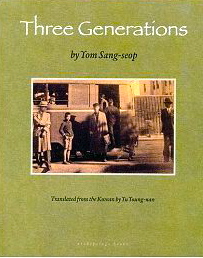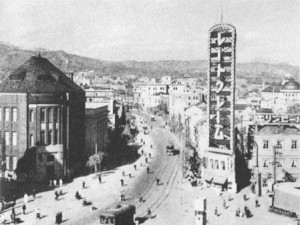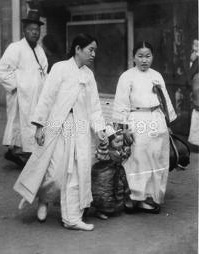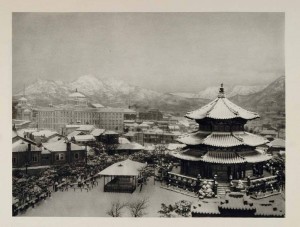“It’s a sin to force a child who doesn’t have much life experience to conform to someone else’s experiences or thoughts, and to the habits they’ve picked up from the crazy world. I think all tragedies begin right there. Furthermore, should we feel contempt for a young person’s dream just because it’s a dream?”
Described as a “masterpiece of Korean fiction of the twentieth century” and as “one of the outstanding literary achievements during Korea’s colonial era,” Three Generations, written in 1931, has recently been translated into English for the first time. Published in Seoul as a newspaper serial from January through August of 1931, author Yom Sang-seop appeals to his Korean audience with his vibrant characters and his depiction of real life, especially as lived by traditional, middle-class Koreans. The action reveals, on the domestic level, the challenges to traditional ways of life and the sociopolitical conflicts of the era.
“masterpiece of Korean fiction of the twentieth century” and as “one of the outstanding literary achievements during Korea’s colonial era,” Three Generations, written in 1931, has recently been translated into English for the first time. Published in Seoul as a newspaper serial from January through August of 1931, author Yom Sang-seop appeals to his Korean audience with his vibrant characters and his depiction of real life, especially as lived by traditional, middle-class Koreans. The action reveals, on the domestic level, the challenges to traditional ways of life and the sociopolitical conflicts of the era.
For western readers, Three Generations is a bit daunting, at first. The Koreans who read the book in 1931 were all too aware that their country was then occupied by the Japanese and had been since 1906, so the author’s failure to mention this as he opens his novel is understandable. Western readers, however, may find it helpful to read the critical Afterword to the book before starting the novel itself. The novel’s unexplained references to the Japanese in Seoul at the beginning of the story, the fact that Deok-gi, the main character, has been studying at Kyoto Prep School and at a Tokyo college, the tensions between some young Koreans and Japanese at a bar, references to “the Third Empire,” and the mysterious political activities of characters referred to as “young Marxists” become more understandable when seen in the context which the Afterword provides.

Keijo in the 1930s, with Japanese sign (not Korean) advertising milk.
The novel traces three generations of one family – the Jo family – consisting of the grandfather and family patriarch, his middle-aged son (Sang-hun, and his wife), and Sang-hun’s 23-year-old son Deok-gi (and his wife and baby), the character around whom most of the action revolves. The family lives in Seoul in a large traditional house with inner and outer quarters, separate living areas for the several families, and spaces for the family’s servants. The grandfather, who governs the family purse strings, has recently married “the Suwon woman,” much younger than he, by whom he has a four-year-old child. The “Suwon woman,” clearly an opportunist, demands obeisance from the other women. Sang-hun, a gambler and ne’er-do-well, has had a lover, Gyeong-ae (a young friend of his son Deok-Gi), by whom he has a young child whom he does not see or adequately support. Sang-hun needs money to pay off debts, and the “Suwon woman” expects to become an heiress. The fact that Deok-gi is widely regarded as the likely heir to most of the grandfather’s money, however, adds to the intrafamily hostilities. As the various characters try to protect their interests, all must carefully watch their backs.

A family dressed in typical Korean fashion, 1930
Within the household, traditional family values are being threatened. The grandfather requires that traditional ancestral rites (very elaborate and expensive) be performed for family members going back as far as ten generations, though Deok-gi finds excuses not to attend. Arranged marriages are sought and performed (even for Deok-gi) to protect the family’s wealth, and real affection is not a requirement since the taking of concubines is accepted. No legal obligations exist between men and these concubines if the women have children, and their difficult lives come under scrutiny here.
As Deok-gi travels around the city, his relationships with many other characters show how traditional society is being challenged. Resentments against the Japanese, the embracing of Marxism by college age students, infiltration of the country by communists from Russia, and turmoil in neighboring China create serious challenges to existing society. A strong police force with no scruples about the use of torture, even on women, acts quickly at even the slightest hint of provocation. Deok-gi is considered a moderate, though he, like the Marxists he has met, believes in and actively works toward improving the lives of the poor and needy, a huge percentage of the population. His friend Kim Byeong-hwa is a revolutionary who has broken from his family over demands that he follow his father’s directions regarding his college education, and his secret meetings with revolutionaries and his attempts to recruit others become a dark subplot of the novel.

Snowy day in Seoul, 1930
Though the author tends to keep his separate plots running on separate tracks and not integrating them as fully as modern novels do, he manages to make the novel interesting and relatively fast-moving. The intricate manipulations within the Jo family keep the complicated lives of its members challenging and absorbing. Though the Afterword points out that author Yom Sang-seop was famous in his era for using the often crude vernacular of his characters, some western readers may find the use of contemporary, twenty-first century slang in this translation quite jarring. Calling a character from 1931 a “wiseass,” or a “piece of work,” and referring to actions such as “talking shit,” “wising up,” and even “chipping in,” feel out of place in a work which is otherwise presented in relatively formal language.
Notes: Keijo in the 1930s, with Japanese sign (not Korean) advertising milk. The photo was probably taken from the Mitsukoshi department store, according to the photo caption. http://koreanhistory.info/oldphotos.htm
Upperclass Koreans wearing traditional clothes, ca. 1930: http://www.gettyimages.com
Image of Keijo (Seoul) in snow, 1930: http://cgi.ebay.com
